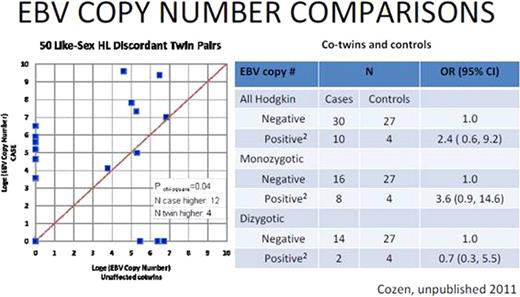Abstract
Abstract 2631
Epstein-Barr Virus (EBV) is a risk factor for some types of Hodgkin lymphoma (HL). Host response to the virus may play a role in pathogenesis and is in part determined by genetic factors. Therefore, using only traditional unrelated controls may not be appropriate.
We compared EBV DNA copy number in peripheral blood mononuclear cells (PBMCs) collected from 63 young adult HL patients in remission and their unaffected co-twins, and 43 spouse controls. Viral load was measured with TaqMan quantitative PCR assays, tested in triplicate and reported as viral copies per million cells. Samples positive in all 3 replicates were classified as positive, and those positive in 1–2 samples were classified as qualitative positive (QP). EBV copy number was log-transformed for some analyses. A binomial proportion test was used to compare EBV copy number in cases and their unaffected co-twins (n=50 like-sex pairs). Conditional (case vs. unaffected co-twin) and unconditional logistic regression (case and unaffected co-twin vs. spouse controls) were used to estimate the effect of EBV copy number on risk as a categorical (positive, QP, or negative) or continuous variable (SAS 9.1). Unconditional logistic regression analyses were adjusted for sex and age.
26% of case, 18% of unaffected co-twins and 9% of spouse controls had positive EBV copy number measurements. Like-sex young adult HL cases had higher EBV copy numbers compared to their unaffected co-twins (P = 0.04). When EBV copy number was considered as a categorical variable, both cases and monozygotic unaffected co-twins were more likely to be positive compared to controls (cases v. controls: Odds Ratio [OR] = 3.2, 95% confidence intervals [CI] = 0.9, 11.1; unaffected co-twins v. controls: OR= 3.6, 95% CI= 0.9, 14.6). However, there was little difference between dizygotic unaffected co-twins and controls (OR= 0.7, 95% CI = 0.5, 5.5).
That young adult HL cases had higher EBV DNA copies than their unaffected co-twins implies that an acquired pre-disease factor or disease affect altered the host response to EBV. However, that both cases and unaffected co-twins had higher EBV DNA copies compared to controls suggests that there is also a heritable component to the host response to EBV.
HL cases > co-twins (acquired or disease effect)
HL cases and co-twins > controls (heritable effect)
No relevant conflicts of interest to declare.
Author notes
Asterisk with author names denotes non-ASH members.


This feature is available to Subscribers Only
Sign In or Create an Account Close Modal